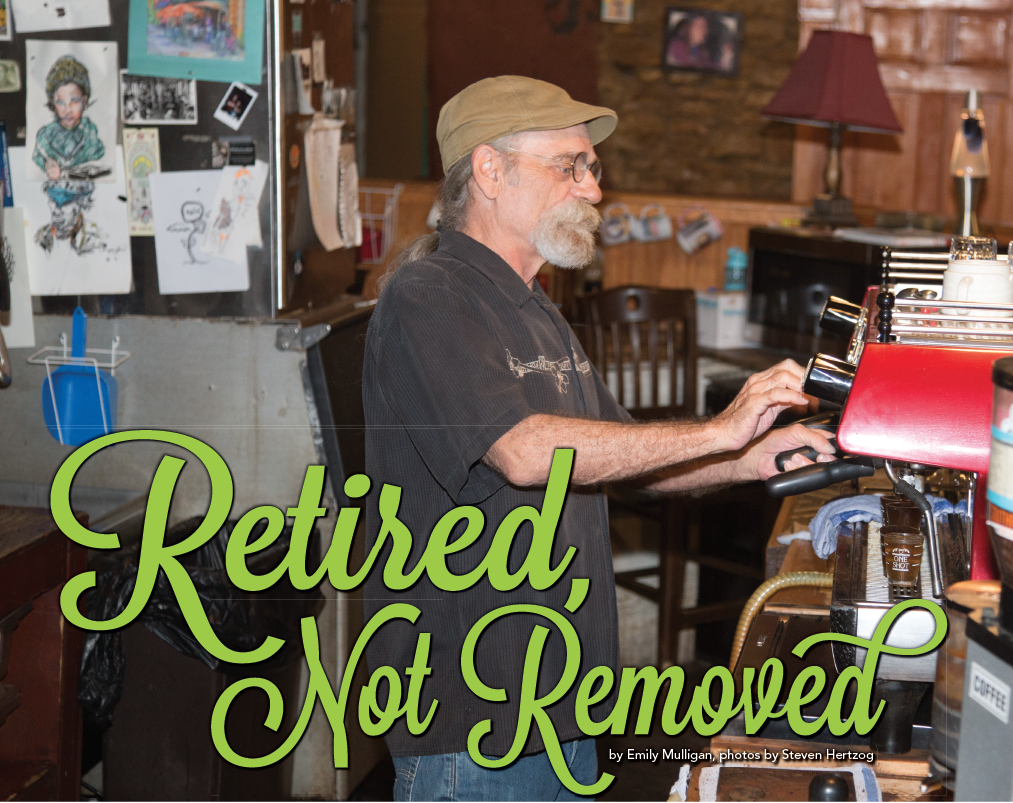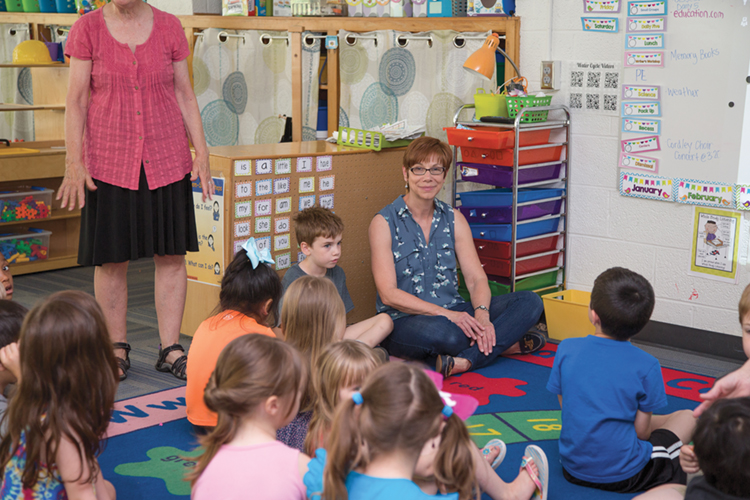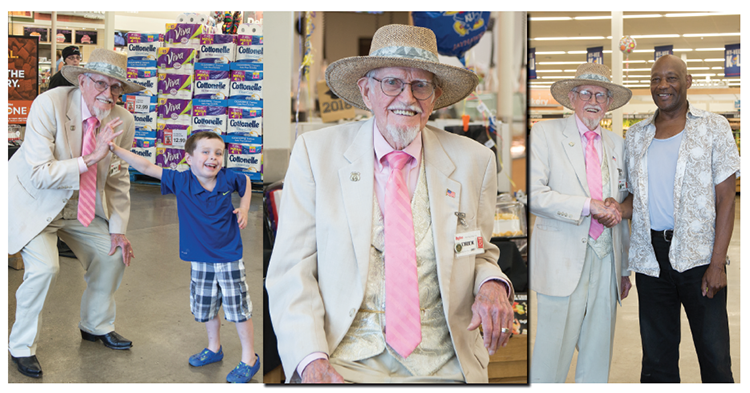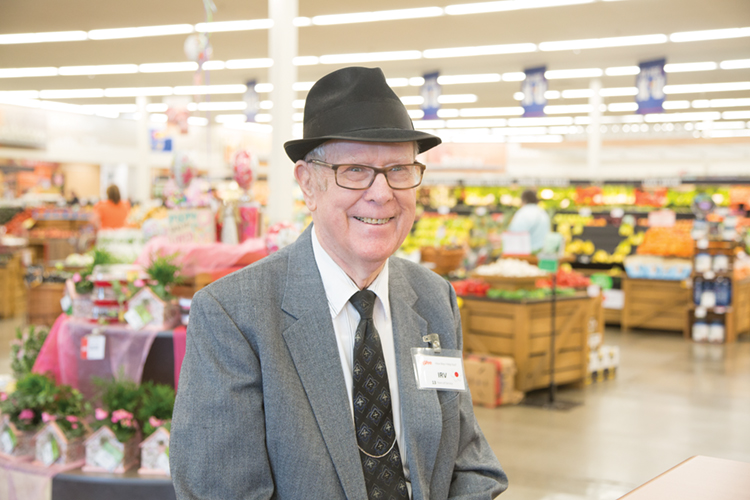These seniors retired from one career only to join the workforce in another capacity for financial or social stimulation.
| 2018 Q2 | story by Emily Mulligan | photos by Steven Hertzog

Craig Daniels, Barista at Henry’s
There isn’t an exact word for it, but there should be. With approximately half of retirees working or having worked after retirement, according to a 2017 study cited in –Investment News–, there is not a concise term that captures the idea of rejoining the workforce after retiring from it.
Making the word “retirement” plural is one way to convey that people might step away from the workforce more than once after their formal retirement at a certain age, as Forbes contributor Robert Laura suggested in 2017.
Many Lawrencians have done this thing-that-has-no-name: officially retired only to go back to work part-time for financial and even social reasons.
Craig Daniels, Mary Barke, Chuck Benedict and Irv Isbell all retired from lengthy careers and now have jobs that keep them interacting within the community.
Craig Daniels, Barista
Craig Daniels was born in Lawrence and moved away as a teenager. After discovering his knack for carpentry at age 16, he came back to Lawrence with a pack on his back to look for a job. Within three days, he found work with the group of people he would end up working with for more than 40 years, building custom homes and doing commercial construction. He was a construction supervisor for most of his career, working on a large range of construction projects, mostly in Lawrence.
“I’m just an old carpenter who became the boss,” Daniels, 63, says. “I carry a class ‘A’ contractor license; one day, I might fix a gate, and another day, I would work on a $2.5 million bank.”
For the past 20 years, Daniels had a regular routine, regardless of where his job site was each day. He stopped by Henry’s coffee shop early in the morning for a cup of coffee on his way to the construction site. “I went every day—I literally never missed,” he says.
Daniels retired in 2017, but before he retired, he thought a lot about what he wanted to do with his time. He was looking forward to dedicating more time to what he calls his “arty stuff” —specialty carpentry projects—and jokes about what else he might do.
“When I was at Henry’s getting my coffee, I’d say to the people there, ‘I’m going to retire and get an easy job like you got,’ ” he quips. “I eventually realized that I’ve been teasing them all this time, and I really do need to get a job at Henry’s.”
And a little less than a year ago, he did just that. He took on a couple of late-night shifts and learned how to make the coffee drinks and ring up sales.
“It was kind of difficult because it was different, but I’m a good organizer, because that’s what I do for building. It’s the easiest job I’ve ever had. If I screw up making the drink, I just make another one. It’s not like what could go bad at a construction site,” he explains.
Daniels says he enjoys being around the younger crowd that patronizes the coffee shop.
“I play certain music—blues, rock ‘n’ roll—stuff the young people haven’t heard before. They’re appreciative; they say I’ve got the best music there is,” he says.
Daniels is settled in at Henry’s, but in the meantime, some of his former coworkers talked him into one last construction job to supervise. So for a few months, he has come out of retirement to oversee extensive renovations in the former Englewood Florist building at 11th and Massachusetts streets.
He is saving money from this project to move to India for six months to a year. As a practicing Hindu, he wants to reconnect with his guru and experience Indian life.
“Every time one of these guys on the project argues with me or lies to me, I just laugh at them and say, ‘This is my India money,’ ” Daniels says.
He spends his spare time with his family. The youngest of his four daughters is 16 and living at home, and his other daughters live nearby with his six grandchildren among them.
Even with the extra construction work, he looks forward to his shifts at Henry’s every week.
“It’s not even a job. It just keeps me out of trouble,” he jokes.

Mary Bark, Substitute Teacher
Mary Barke, Substitute Teacher
As an elementary school classroom teacher for 30 years, Mary Barke felt guilty every time she missed a day with her children, and they had to have a substitute teacher. Now, as a substitute, her goal is to set classroom teachers’ minds at ease when she takes over for a day.
“What I like to hear from the teacher is, ‘I knew I didn’t need to worry because you were going to be here today,’ ” she says.

Alea Lafond – Substitute Teacher
Barke was a dental assistant in Salina for seven years before she decided to leave home and go to college. She came to the University of Kansas (KU) because it was farthest from home, and she put herself through school, becoming the first person in her family to graduate.
She felt drawn to younger elementary students and began her career as a kindergarten teacher, first at KU’s Hilltop Child Development Center and then at Cordley, Riverside and Deerfield elementary schools. She then moved on to teach what was called “transitional first grade” to students who needed an extra boost, then traditional first grade, then second grade. She spent most of her career at Cordley, and that is where she retired from in 2014.
She had considered retiring for a few years, and when Cordley was going to temporarily relocate to East Heights Elementary while it underwent extensive renovations, Barke saw her opportunity.
Not one to sit still or slack off, Barke began substituting the school year following her retirement. She knew the staff at Cordley well, and after having worked for 30 years in the school district, she knew teachers and principals throughout the district. So substituting was a chance to stay connected with colleagues, in addition to enjoying time with the students.
But her time as a substitute also has allowed her a much broader horizon, she says—she has taken this opportunity to try new challenges.
“I have pushed myself out of the box as a substitute. I have done every grade level, taught P.E. [physical education], art, title reading, title math and even ESL [English as a second language] small groups,” she explains. “I have gotten to know so many different people and have seen all the wonderful things that teachers are doing, especially the younger generation.”
Although she chooses to work most days, Barke likes having the ability to decline a substitute gig if she wants to spend time with her uncle or her brother, or has other plans. She also works on the weekends and during the summer at The Etc. Shop downtown, something she has enjoyed doing for years.
Substituting comes with its challenges, not the least of which is learning a new set of names each day. “I really appreciate when the teachers give me a folder that has pictures next to the kids’ names,” she says.
That aside, Barke says she has more energy at the end of each school day than she did when she was teaching full-time.
“I don’t miss the paperwork at all or the meetings. It’s kind of nice; I get to go home at 4:00,” she says. “I also get to enjoy the kids again. Teaching full-time, you start to feel overwhelmed by everything. I don’t feel like I actually retired, just changed direction on what I was doing. I still work just as much as I did before.”

Chuck Benedict, HyVee Greeter
Chuck Benedict and Irv Isbell, Hy-Vee Greeters
Chuck Benedict and Irv Isbell are the longtime friendly faces at the front doors of the Clinton Parkway Hy-Vee store. Benedict has been a greeter since 2007, and Isbell has worked at Hy-Vee since 2001.
“Irv and I are people’s first opportunity to get a welcome and see a smile,” Benedict says. “I want them to know we really appreciate their business. When I say, ‘Thank you for choosing to shop at Hy-Vee,’ people really respond.”
On game days, Benedict, who is 92, often wears KU gear, either a football jersey and shoulder pads, or a basketball uniform, depending on the season. One busy day, he decided to count how many people he greeted. In two hours and 15 minutes, he says he spoke to more than 500 people.
Benedict came to Lawrence to live near his daughter, Cindy Barclay, and her family after the death of his second wife. He is originally from central Illinois, where he and his family owned and operated a gas service station that was on Route 66 and later along the interstate. He also served stateside as a gunner in the Army Air Corps in the B-24 specialized bomber.
He loves to dance—he met both of his wives that way—and has 12 grandchildren and 14 great-grandchildren who all live in Lawrence.
Isbell says he “got tired of sitting around at home,” and that is why he applied for the job at Hy-Vee. He spent his first year assisting a disabled greeter before taking on the greeting duties on his own. Now, he and Benedict work on separate days. Although he admits to slowing down a bit recently, Isbell, 87, says he looks forward to his shifts because of the friendly shoppers.

Irv Isbell, Hyvee Greeter
“I can count all on one hand the number of people who have not been nice to me in 17 years,” he says. “I don’t have any intention of retiring. I like visiting with all the people. I know their names, and people recognize me outside of the store.”
After beginning a career in construction—he moved to Kansas from Arkansas to help build an addition to the Learned State Hospital—Isbell worked for 43 years selling cemetery property and funeral services in Kansas, Nebraska and Oklahoma. His service in the Air Force during the Korean War briefly interrupted his construction career. He and his wife of 61 years, Mary, have lived in Lawrence since his retirement 27 years ago. They have 10 grandchildren and three great-grandchildren, and are active in their church.

